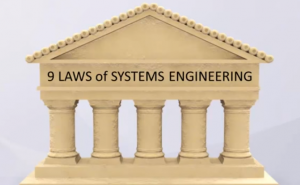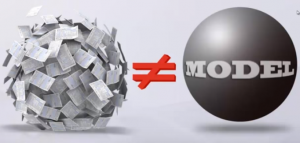9 Laws of Systems Engineering

During my last session of YouTube foraging ( oh, you don’t want to see my view history … ) I stumbled upon this gem. Thought it’s a really good webinar, spot-on and directly to the core. I’d say it’s short, even though you wouldn’t say just based on video length. It addresses the basics very briefly and clearly enough, so I’d share with you all.
It might come useful to explain that everlasting question on what is Systems Engineering and what is it you’re doing. Then the blank stare and quick subject change when you’re trying to explain. This probably still won’t make things much clearer, but just saying … Maybe it’s easier to just say you’re assembling jigsaws when asked: “we are the ones who get things work!”. Because they’ll fit together. It’s magic!
Systems Engineering provides us with perspective, it keeps the design effort from becoming lost, keeps the effort on track and it allows us to get where we’re going.
These processes also allow the teams to work across disciplines without becoming lost or at odds with one another.
Systems Engineering keeps the design effort from devolving into component engineering process.
What follows is a brief summary as I got it, original video embedded at the end. The italicised text are my own thoughts and comments.
1. Begin with the End in Mind
- Our end is serving the customer. It all begins and ends with the customer’s needs.
The customer has needs …
- The place where we’re going is the satisfaction of our customer’s needs.
If you don’t know where you’re going, you’ll end up someplace else — Yogi Berra
- No matter what you order, you get what they have in a restaurant. Always a different price for the same breakfast.
- For SE is always Perspective, perspective, perspective, the same way as for real estate Location, location, location.
2. It doesn’t help to solve the wrong problem
- Understand the problem — because Einstein arguably said one should spend 99% of the time defining the problem …
We fail more often because we solve the wrong problem than because we get the wrong solution to the right problem. — Russel Acknoff
- Try not to end up with a solution in search for a problem — this is way too easy, especially if you’re working in an industry with a long tradition. Still pushing the same model, iterate on the same product? It may work, it may be needed to reinvent yourself.
A perfection of means and a confusion of aims seems to be our main problem. — Albert Einstein
3. Insight is the Goal
- Understand the problem, the domains and relationships — back to Einstein? And Hitch?
- The model is the key for that understanding, allows to prevent adding our own preconceived perspective.
A point of view can be a dangerous luxury when substituted to insight and understanding.
4. The Model is the main thing
- Needs to be as simple as possible BUT not simpler. Remember the map is not the territory!
- Model describes the system — describes the problem and the solution that solves the problem.
- Model makes the system focus — Remember the main thing is to keep the main thing the main thing?
- Documents flow from the model.
5. To Catch (Design) a System You have to Think like one
- Analytic & Synthetic Thinking go hand in hand
- can’t use Analytic Thinking alone — explains what’s a system
- Lack of Synthetic Thinking
- Unintended Consequences.
6. It’s all about Relationships
- Relationships describe how a system works
- Metamodel or schema
- relationships become the Framework for the model
- relationships are the Pathways for traceability
7. Even a Set of Views is Not a Model


- views are responses to database queries

- views help us understand and communicate the model
- views are NOT the model
8. Choose the Representation that Best Suits the Audience
- Who are they and what will speak to them?
- What do they need to know?
- What do we need them to know?
9. Systems come in 3's
- the Design of the actual system
- the Context — when you forget that you invite in unintended consequences
- the Design Process — most often missed in the sense that we don’t stop to be intentional about it. Should be efficient and effective, constantly being refined.
- James Martin posits seven systems, “The Seven Samurai of Systems Engineering: Dealing with the Complexity of 7 Interrelated Systems” article (Martin 2004)
Originally published at https://alextoth.eu.



Comments
Post a Comment